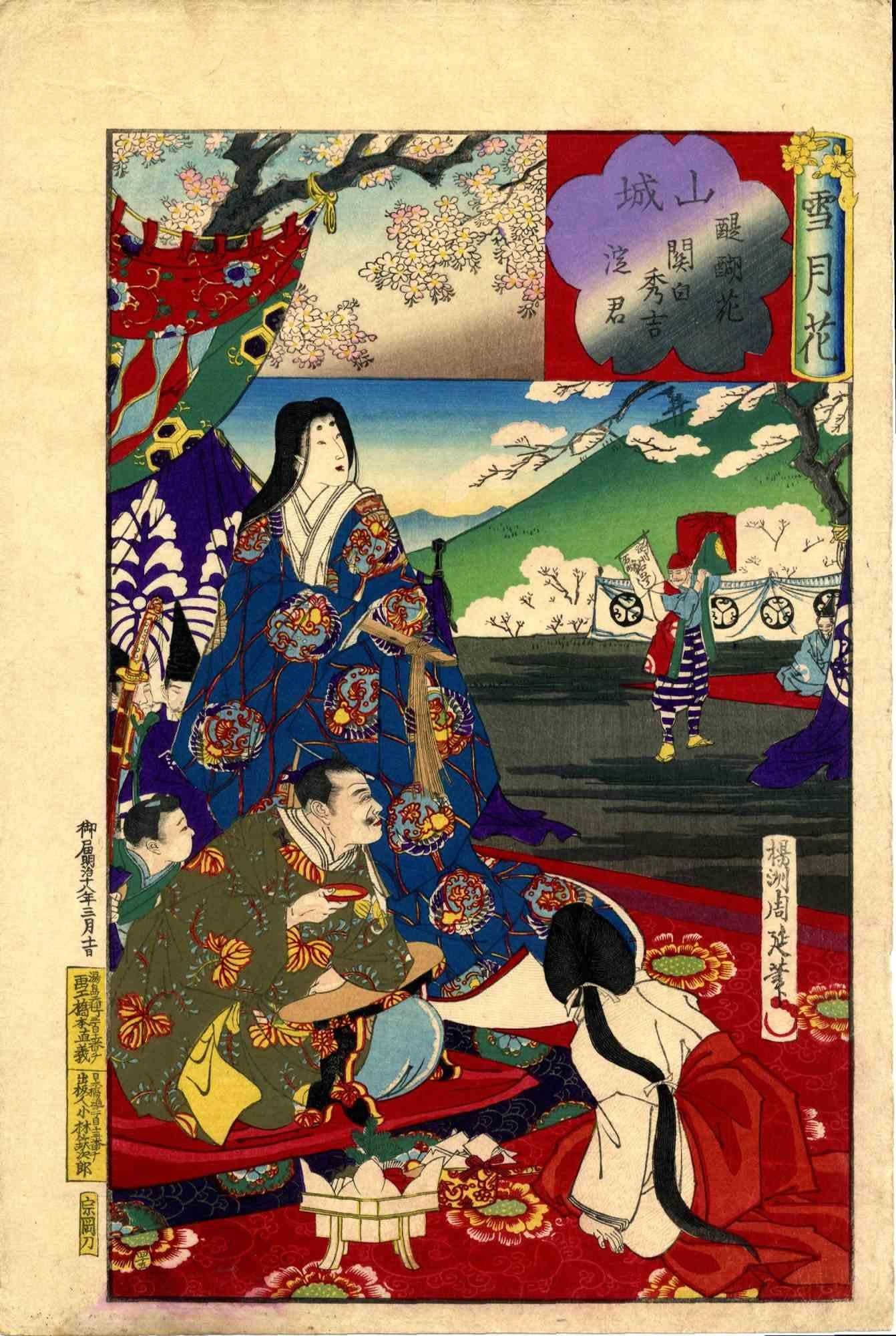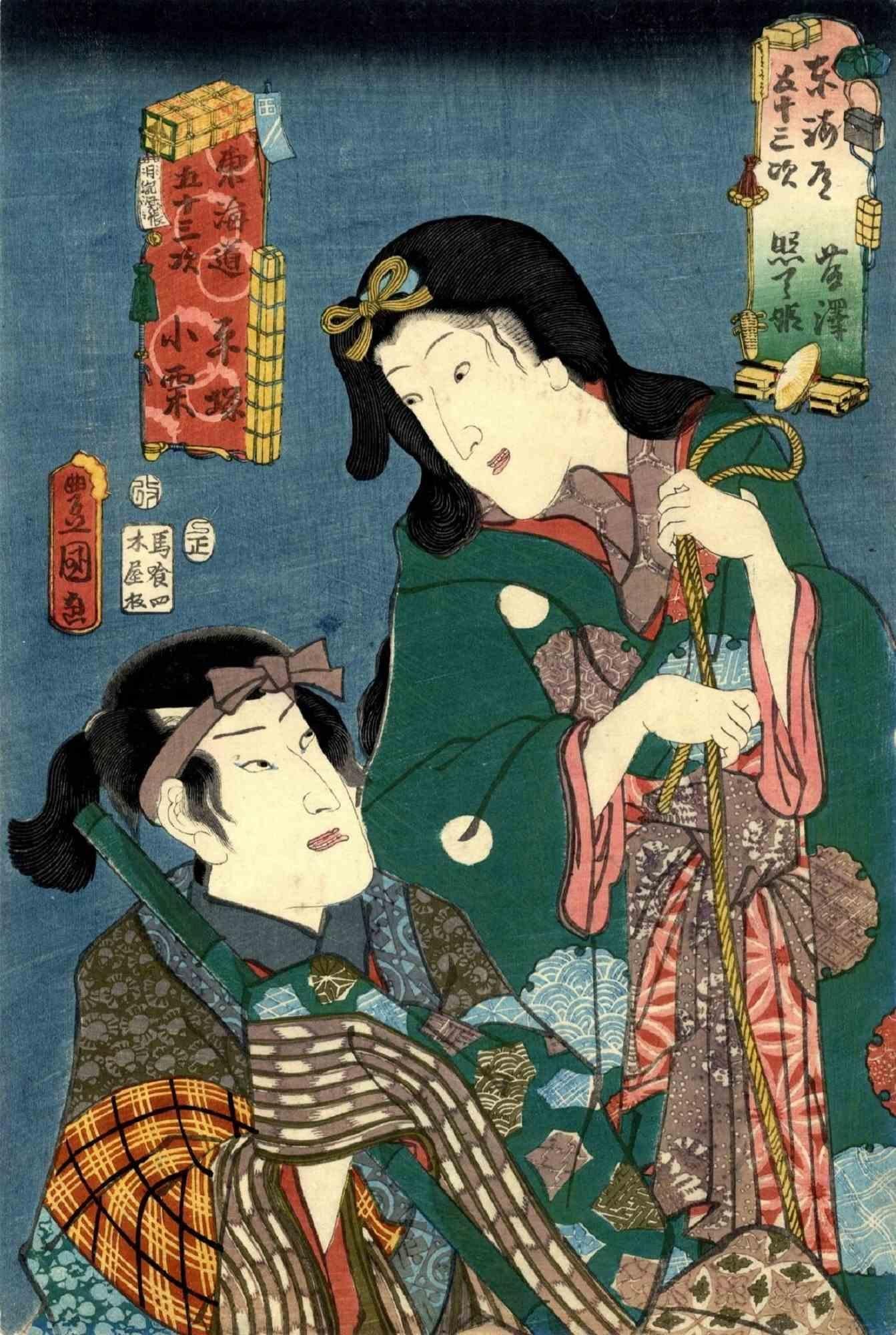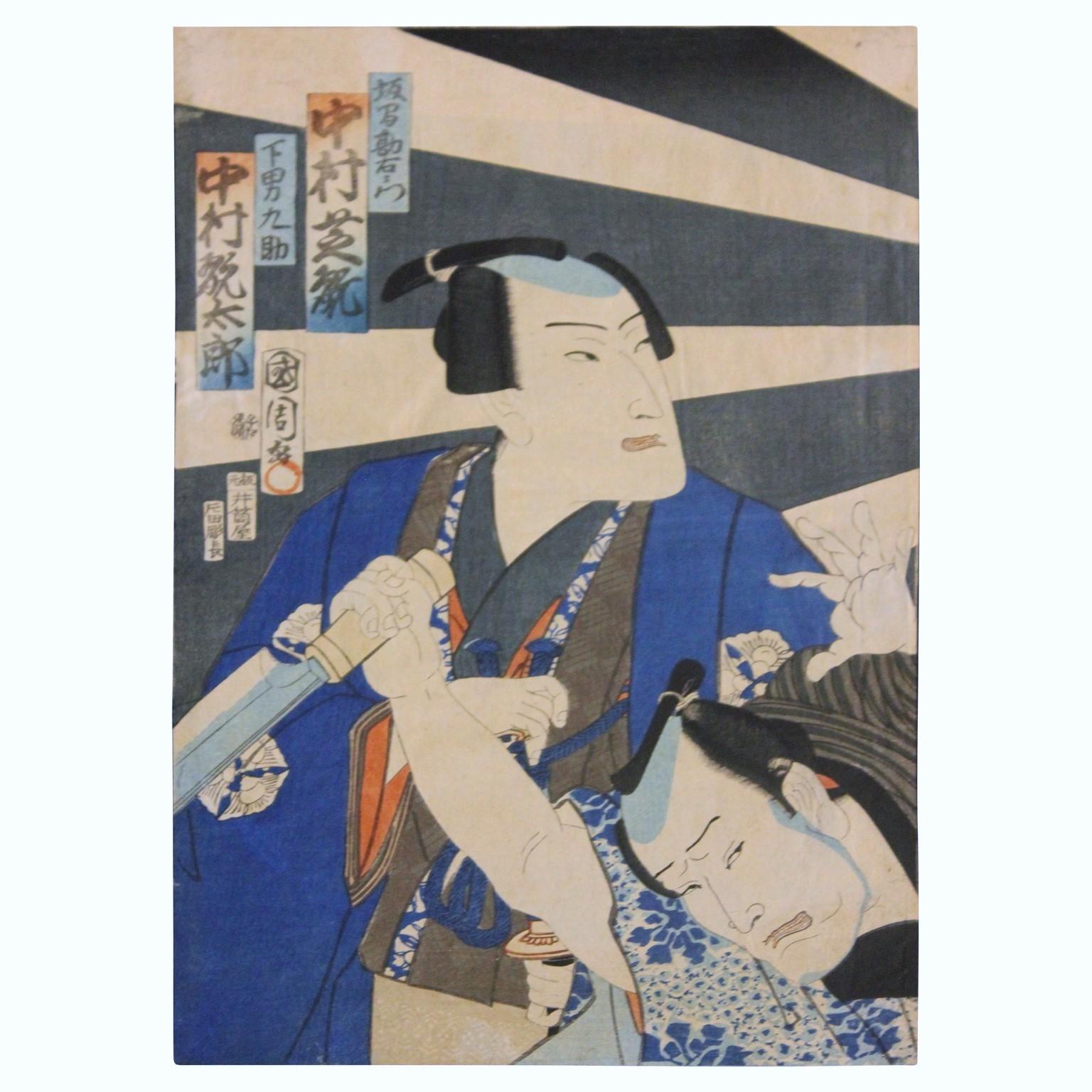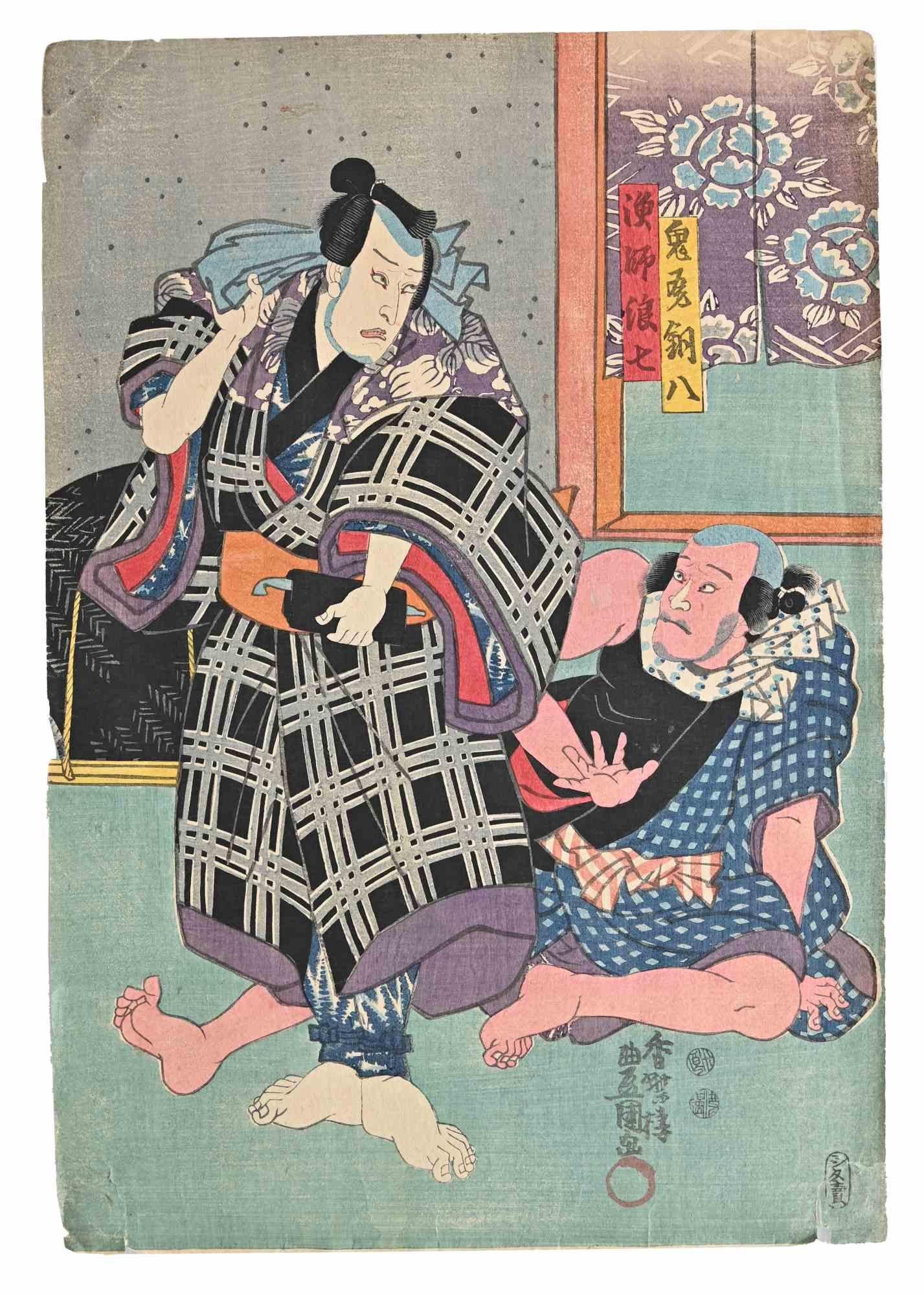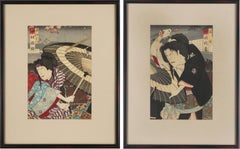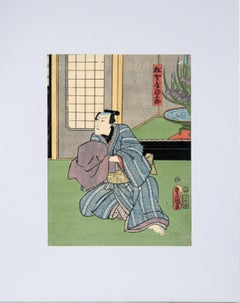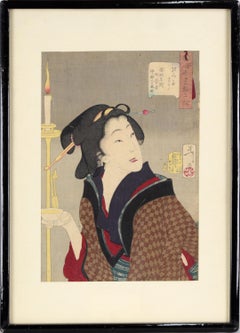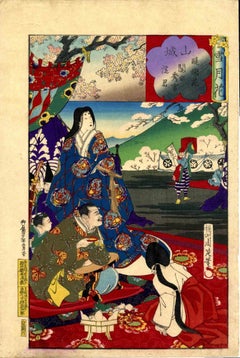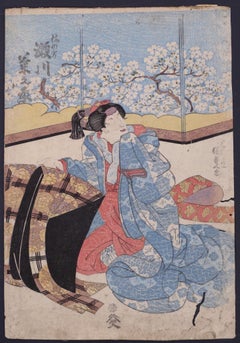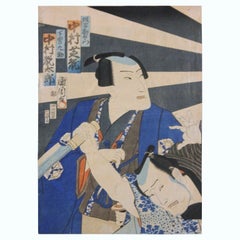Items Similar to Two Actors - Japanese Woodblock by Chikanobu Yoshu
Want more images or videos?
Request additional images or videos from the seller
1 of 10
Toyohara ChikanobuTwo Actors - Japanese Woodblock by Chikanobu Yoshu1890's
1890's
$875
£664.58
€767.81
CA$1,226.34
A$1,372.51
CHF 716.34
MX$16,737.54
NOK 9,168.24
SEK 8,678.91
DKK 5,730.10
Shipping
Retrieving quote...The 1stDibs Promise:
Authenticity Guarantee,
Money-Back Guarantee,
24-Hour Cancellation
About the Item
Two Actors - Japanese Woodblock by Toyohara Chikanobu (豊原周延, 1838–1912), better known to his contemporaries as Yōshū Chikanobu (楊洲周延).
Colorful and expressive court scene. Two actors, both wearing extravagant kimonos, one kneeling facing left, while the other is above, looking down, a fan in his hand. A cherry tree is seen above. Vibrant blues and reds make up this woodblock.
Signed "Yōshū Chikanobu" (楊洲周延)
Publisher: Fukuda Hatsujiro
Frame size: 18.5"H x 13.5"W
Image size: 14.25"H x 10"W
Chikanobu Toyohara (Japanese, 1838-1912) better known to his contemporaries as Yōshū Chikanobu (楊洲周延), was a Japanese painter and printmaker who was widely regarded as a prolific woodblock artist during the Meiji epoch.
In 1875 (Meiji 8), he decided to try to make a living as an artist. He travelled to Tokyo. He found work as an artist for the Kaishin Shimbun. In addition, he produced nishiki-e artworks. In his younger days, he had studied the Kanō school of painting; but his interest was drawn to ukiyo-e. He studied with a disciple of Keisai Eisen and then he joined the school of Ichiyūsai Kuniyoshi; during this period, he called himself Yoshitsuru. After Kuniyoshi’s death, he studied with Kunisada. He also referred to himself as Yōshū.
Like many ukiyo-e artists, Chikanobu turned his attention towards a great variety of subjects. His work ranged from Japanese mythology to depictions of the battlefields of his lifetime to women's fashions. As well as a number of the other artists of this period, he too portrayed kabuki actors in character, and is well known for his impressions of the mie (mise en scène) of kabuki productions. Chikanobu was known as a master of bijinga, images of beautiful women, and for illustrating changes in women's fashion, including both traditional and Western clothing. His work illustrated the changes in coiffures and make-up across time. For example, in Chikanobu's images in Mirror of Ages (1897), the hair styles of the Tenmei era, 1781-1789, are distinguished from those of the Keiō era, 1865-1867. His works capture the transition from the age of the samurai to Meiji modernity, the artistic chaos of the Meiji period exemplifying the concept of "furumekashii/imamekashii".
"The Korean Uprising of 1882" — woodblock print by Chikanobu
Chikanobu is a recognizable Meiji period artist,[8] but his subjects were sometimes drawn from earlier historical eras. For example, one print illustrates an incident during the 1855 Ansei Edo earthquake.[9] The early Meiji period was marked by clashes between disputing samurai forces with differing views about ending Japan's self-imposed isolation and about the changing relationship between the Imperial court and the Tokugawa shogunate.[10] He created a range of impressions and scenes of the Satsuma Rebellion and Saigō Takamori.[11] Some of these prints illustrated the period of domestic unrest and other subjects of topical interest, including prints like the 1882 image of the Imo Incident, also known as the Jingo Incident (壬午事変, jingo jihen) at right.
The greatest number of Chikanobu's war prints (戦争絵, sensō-e) appeared in triptych format. These works documented the First Sino-Japanese War of 1894-1895. For example, the "Victory at Asan"[12] was published with a contemporaneous account of the July 29, 1894 battle.
- Creator:Toyohara Chikanobu (1838 - 1912, Japanese)
- Creation Year:1890's
- Dimensions:Height: 18.5 in (46.99 cm)Width: 13.5 in (34.29 cm)Depth: 1 in (2.54 cm)
- Medium:
- Movement & Style:
- Period:
- Condition:Artwork is in good condition. Color is strong with minor creasing along edges of paper consistent with age. Frame and mat included as-is.
- Gallery Location:Soquel, CA
- Reference Number:Seller: N90521stDibs: LU54213807242
About the Seller
5.0
Platinum Seller
Premium sellers with a 4.7+ rating and 24-hour response times
Established in 1986
1stDibs seller since 2014
2,948 sales on 1stDibs
Typical response time: <1 hour
- ShippingRetrieving quote...Shipping from: Soquel, CA
- Return Policy
Authenticity Guarantee
In the unlikely event there’s an issue with an item’s authenticity, contact us within 1 year for a full refund. DetailsMoney-Back Guarantee
If your item is not as described, is damaged in transit, or does not arrive, contact us within 7 days for a full refund. Details24-Hour Cancellation
You have a 24-hour grace period in which to reconsider your purchase, with no questions asked.Vetted Professional Sellers
Our world-class sellers must adhere to strict standards for service and quality, maintaining the integrity of our listings.Price-Match Guarantee
If you find that a seller listed the same item for a lower price elsewhere, we’ll match it.Trusted Global Delivery
Our best-in-class carrier network provides specialized shipping options worldwide, including custom delivery.More From This Seller
View AllJapanese Figurative Edo Woodblock Set of Two
By Toyohara Kunichika
Located in Soquel, CA
Alluring two-piece edo woodblock print of Japanese actors by Toyohara Kunichika (Japanese, 1835-1900). Titled, dated and signed on verso. Presented...
Category
1880s Edo Figurative Prints
Materials
Paper, Ink, Woodcut
$700 Sale Price
20% Off
"Sun Saburo Matsugaya" - Mid 19th Century Figurative Japanese Woodblock Print
By Utagawa Kunisada (Toyokuni III)
Located in Soquel, CA
"Sun Saburo Matsugaya" - Mid 19th Century Figurative Japanese Woodblock Print
Beautiful mid 19th century figural Japanese woodblock print of a seated man with lilies in the background by Utagawa Toyokuni III (Kunisada) (Japanese, 1786-1864/5). Artist's chop is in the lower right corner of the piece. The actor is Magosaburo Matsugaya from the play "Katakiuchi Rumors"
Presented in a new grey-blue mat with foamcore backing.
Mat size: 21"H x 16"W
Paper size: 14"H x 9.75"W
During his lifetime Kunisada Utagawa...
Category
1850s Edo Figurative Prints
Materials
Paper, Ink, Woodcut
"Thirsty: the appearance of a town geisha in the Ansei era" - Woodblock on Paper
By Tsukioka Yoshitoshi
Located in Soquel, CA
"Thirsty: the appearance of a town geisha in the Ansei era" - Woodblock on Paper
From the series "Thirty-two Aspects of Customs and Manners" (Fuzoku sanjuniso)
Lively woodblock of a...
Category
1880s Edo Figurative Prints
Materials
Paper, Ink, Woodcut
The Courtesan Kashiwagi and the Kamuro Wakano - Japanese Woodblock Print
By Utagawa Kunisada (Toyokuni III)
Located in Soquel, CA
The Courtesan Kashiwagi and the Kamuro Wakano - Japanese Woodblock Print
Original Toyokuni III/Kunisada (Japanese, 1786 - 1864) Japanese Woodblock Print
"The Courtesan Kashiwagi and...
Category
1820s Realist Figurative Prints
Materials
Printer's Ink, Rice Paper, Woodcut
Japanese Original Woodblock Print
Located in Soquel, CA
Japanese Original Woodblock Print
Harunobu Suzuki (né Hozumi) (Japanese, 1724 - 1770)
Presented in a black mat.
Mat: 16"H x 12"W
Paper: 12"H x 9"W
I...
Category
18th Century Edo Figurative Prints
Materials
Ink, Rice Paper, Woodcut
"First Horse Day, 1896" - Chiyoda Palace - Japanese Woodblock by Chikanobu Yoshu
By Toyohara Chikanobu
Located in Soquel, CA
"First Horse Day, 1896" - Chiyoda Palace - Japanese Woodblock by Chikanobu Yoshu
Colorful and expressive court scne by Toyohara Chikanobu,"Yoshu" (Japanese, 1838-1912).
This is the r...
Category
1890s French School Figurative Prints
Materials
Ink, Rice Paper, Woodcut
You May Also Like
The Flowering Daigo - Woodcut by Toyohara Chikanobu - 1885
By Toyohara Chikanobu
Located in Roma, IT
The Flowering Daigo is an original artwork realized in 1885 by Toyohara Chikanobu (1838–1912).
Limited edition woodcut print signed on plate.
From the series "Setsu gekka", (Snow, ...
Category
1880s Modern Figurative Prints
Materials
Woodcut
Portrait of Two Actors - Woodcut Print by Utagawa Kunisada - 1857
Located in Roma, IT
Portrait of Two Actors is an original modern artwork realized by Utagawa Kunisada (Japanese, active 1825–75) in 1857.
Woodcut print oban format, 1857. Signature: Toyokuni ga. Censor...
Category
19th Century Modern Figurative Prints
Materials
Woodcut
Kabuki Theatre Scene - Original Woodblock print by Utagawa Toyokuni II - 1810 ca
By Utagawa Toyokuni II
Located in Roma, IT
Kabuki Theatre Scene is a color woodblock print on paper, realized by Utagawa Toyokuni II around 1810 ca.
This lovely ukiyo-e print depicts a kneeling actress, more precisely a geis...
Category
1810s Landscape Prints
Materials
Paper
Two Kabuki Actors Japanese Woodblock Print
By Toyohara Kunichika
Located in Houston, TX
Two kabuki actors posing a samurai's. The print is printed on rice paper and is not framed. It is stamped by the artist with details about the actors in ...
Category
1860s Edo Portrait Prints
Materials
Woodcut
Kabuki Scene - Woodblock Print by Utagawa Kunisada - Mid-19th Century
By Utagawa Kunisada (Toyokuni III)
Located in Roma, IT
Kabuki Scene is an original Woodcut print realized in mid 19 century by Utagawa Kunisada.
Good condition and Beautiful colored woodblock print.
This wonderful modern artwork repr...
Category
Mid-19th Century Modern Figurative Prints
Materials
Woodcut
Yugiri - Woodcut by Utagawa Kunisada - 1850s
By Utagawa Kunisada (Toyokuni III)
Located in Roma, IT
Yugiri is an original artwork realized in the 1850s by Utagawa Kunisada (1786-1865).
Chapter 39 of the story Genji Monogatari. Color woodcut around 1851. Signed: Ichiyossai Toyokun...
Category
1850s Modern Figurative Prints
Materials
Woodcut
More Ways To Browse
Antique Japanese Mirrors
Antiques Fans
Meiji Woodblock
Antique Cherry Mirror
1912 Mirror
Antique Korean Painting
Purple Kimono
Antique Earthquake
Antique Triptych Mirror
Antique Korean Prints
Japanese Woodblock Print Kuniyoshi
Kunisada Triptych
Japanese Imperial Kimono
Edo Satsuma
Chikanobu Woodblock Print
Keisai Eisen
Kawase Hasui Japanese Woodblock Print
Kiyoshi Woodcut
